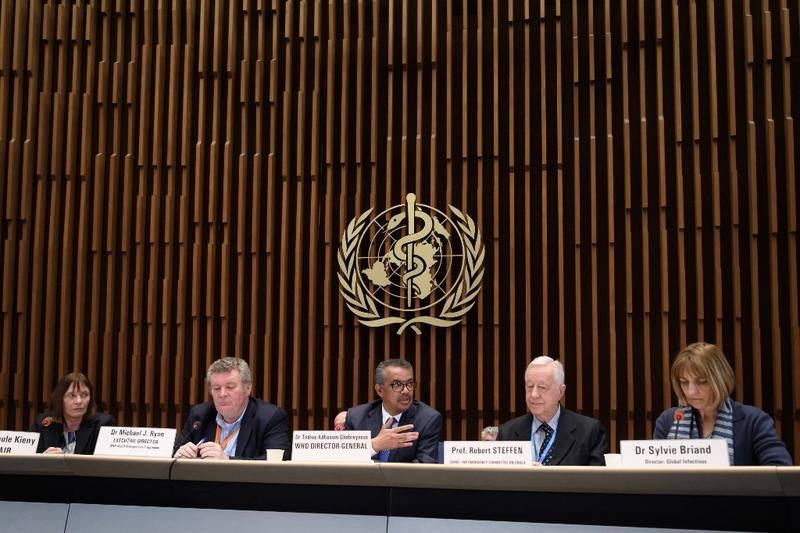 (From left) World Health Organization (WHO) Co-chair Marie-Paule Kieny, WHO Health Emergencies Programme head Michael Ryan, WHO Director-General Tedros Adhanom Ghebreyesus, WHO Chair of Emergency Committee on Ebola Robert Steffen and WHO Director Infectious Hazards Managment Sylvie Briand attend a combined news conference following a two-day international conference on COVID-19 coronavirus vaccine research and a meeting to decide whether Ebola in DR Congo still constitutes health emergency of international concern on January 12, 2020 in Geneva. T
(FABRICE COFFRINI / AFP)
(From left) World Health Organization (WHO) Co-chair Marie-Paule Kieny, WHO Health Emergencies Programme head Michael Ryan, WHO Director-General Tedros Adhanom Ghebreyesus, WHO Chair of Emergency Committee on Ebola Robert Steffen and WHO Director Infectious Hazards Managment Sylvie Briand attend a combined news conference following a two-day international conference on COVID-19 coronavirus vaccine research and a meeting to decide whether Ebola in DR Congo still constitutes health emergency of international concern on January 12, 2020 in Geneva. T
(FABRICE COFFRINI / AFP)
GENEVA - The World Health Organization (WHO) released on Friday lists of research priorities and actions soon to take against the epidemic of COVID-19, which were agreed upon during a global research and innovation forum aiming to curb the outbreak.
The two-day forum on COVID-19, which concluded in Geneva on Wednesday, identified nine thematic areas of research on the outbreak.
READ MORE: Xi stresses improving mechanism for epidemic prevention, control
First, to better understand the natural history, transmission and diagnostics of the virus, scientists will develop disease models, including animal models for infection, disease and transmission, and develop tools and studies to monitor phenotypic change and potential adaptation of the virus, while supporting implementation of diagnostics and products to improve clinical processes.
The WHO also specified some immediate actions to take, including mobilizing research on rapid point-of-care diagnostics for use at the community level, and learning what standard of care approaches from China and elsewhere are the most effective
Second, researchers will try to identify animal host(s) and any evidence of continued spill-over to humans, and to understand the socioeconomic and behavioral risk factors for this spill-over.
Third, the epidemiological studies will focus on understanding the transmission dynamics of the virus, defining the severity of disease, understanding susceptibility of populations, and identifying what public health mitigation measures could be effective for control.
Fourth, clinical characterization and management will try to define the natural history of the disease, develop a core clinical outcome set to maximize usability of data across a range of trials, and determine adjunctive and supportive interventions to improve the clinical outcomes of infected patients.
Fifth, infection prevention and control, including health care workers' protection, should be strengthened by optimizing the use of personal protective equipment (PPE) and minimizing the role of the environment in transmission.
Sixth, candidate therapeutics R&D will focus on developing animal models and standardizing challenge studies, developing prophylaxis clinical studies and prioritizing in healthcare workers.
Seventh, candidate vaccines R&D will focus on optimizing clinical trial design, including for Phase III/prioritized candidates for testing, understanding approaches to evaluate risk for enhanced disease after vaccination, and developing assays to evaluate vaccine immune response and process development for vaccines.
ALSO READ: China develops plasma therapy for coronavirus patients
Eighth, ethical considerations for research will include articulating and translating existing ethical principles and standards to salient issues in COVID-2019, embedding ethics across all thematic areas, and supporting sustained education, access, and capacity building in the area of ethics.
And ninth, social sciences in the outbreak response will, among other measures, identify the underlying drivers of fear, anxiety and stigma that fuel misinformation and rumor, particularly through social media.
Meanwhile, WHO has also specified some immediate actions to take, including mobilizing research on rapid point-of-care diagnostics for use at the community level, learning what standard of care approaches from China and elsewhere are the most effective, and broadly and rapidly sharing virus materials, clinical samples and data for immediate public health purposes.


